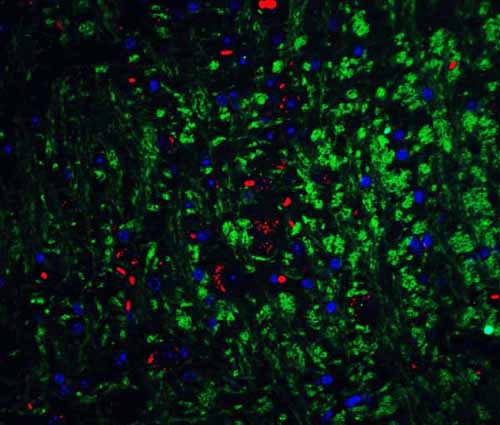AKT1S1 Antibody
- SPECIFICATION
- CITATIONS
- PROTOCOLS
- BACKGROUND

Application
| WB, IHC-P, IF, E |
|---|---|
| Primary Accession | Q96B36 |
| Other Accession | NP_115751, 84335 |
| Reactivity | Human, Mouse, Rat |
| Host | Rabbit |
| Clonality | Polyclonal |
| Isotype | IgG |
| Calculated MW | Predicted: 30 kDa Observed: 28 kDa |
| Application Notes | AKT1S1 antibody can be used for detection of AKT1S1 by Western blot at 1 - 2 μg/mL. |
| Gene ID | 84335 |
|---|---|
| Target/Specificity | AKT1S1 antibody was raised against a 19 amino acid peptide near the carboxy terminus of human AKT1S1. The immunogen is located within amino acids 190 - 240 of AKT1S1. |
| Reconstitution & Storage | AKT1S1 antibody can be stored at 4℃ for three months and -20℃, stable for up to one year. |
| Precautions | AKT1S1 Antibody is for research use only and not for use in diagnostic or therapeutic procedures. |
| Name | AKT1S1 {ECO:0000312|EMBL:AAH16043.1} |
|---|---|
| Function | Negative regulator of the mechanistic target of rapamycin complex 1 (mTORC1), an evolutionarily conserved central nutrient sensor that stimulates anabolic reactions and macromolecule biosynthesis to promote cellular biomass generation and growth (PubMed:17510057, PubMed:17386266, PubMed:17277771, PubMed:29236692). In absence of insulin and nutrients, AKT1S1 associates with the mTORC1 complex and directly inhibits mTORC1 activity by blocking the MTOR substrate- recruitment site (PubMed:29236692). In response to insulin and nutrients, AKT1S1 dissociates from mTORC1 (PubMed:17386266, PubMed:18372248). Its activity is dependent on its phosphorylation state and binding to 14-3-3 (PubMed:16174443, PubMed:18372248). May also play a role in nerve growth factor-mediated neuroprotection (By similarity). |
| Cellular Location | Cytoplasm, cytosol {ECO:0000250|UniProtKB:Q9D1F4}. Note=Found in the cytosolic fraction of the brain. {ECO:0000250|UniProtKB:Q9D1F4} |
| Tissue Location | Widely expressed with highest levels of expression in liver and heart. Expressed at higher levels in cancer cell lines (e.g. A-549 and HeLa) than in normal cell lines (e.g. HEK293) |

Thousands of laboratories across the world have published research that depended on the performance of antibodies from Abcepta to advance their research. Check out links to articles that cite our products in major peer-reviewed journals, organized by research category.
info@abcepta.com, and receive a free "I Love Antibodies" mug.
Provided below are standard protocols that you may find useful for product applications.
Background
AKT1S1 Antibody: The Akt signaling pathway contributes to the regulation of apoptosis after a variety of cell death signals. AKT1S1, also known as PRAS40, is a proline-rich substrate of the kinase AKT1 and is thought to play a role in neuroprotection mediated by nerve growth factor (NGF) after transient focal cerebral ischemia (1). AKT1S1 is also a substrate and potential regulator of mammalian target of rapamycin (mTOR), a serine/threonine kinase that regulates cell growth and cell cycle, and a negative regulator of autophagy (2). Treatment with the insulin-like growth factor-1 (IGF1) can indusce the phosphorylation of AKT1S1 via the PI3K/AKT signaling pathway in PC12 cells (3).
References
Saito A, Narasimhan P, Hayashi T, et al. Neuroprotective role of a proline-rich Akt substrate in apoptotic neuronal cell death after stroke: relationships with nerve growth factor. J. Neurosci. 2004; 24:1584-93.
Wiza C, Nascimento EB, and Ouwens DM. Role of PRAS40 in Akt and mTOR signaling in health and disease. Am. J. Physiol. Endocrinol. Metab. 2012; 302:E1453-60.
Wang H, Zhang Q, Zhang L, et al. Insulin-like growth factor-1 induces the phosphrylation of PRAS40 via the PI3K/Akt signaling pathway in PC12 cells. Neurosci. Lett. 516:105-9.
If you have used an Abcepta product and would like to share how it has performed, please click on the "Submit Review" button and provide the requested information. Our staff will examine and post your review and contact you if needed.
If you have any additional inquiries please email technical services at tech@abcepta.com.













 Foundational characteristics of cancer include proliferation, angiogenesis, migration, evasion of apoptosis, and cellular immortality. Find key markers for these cellular processes and antibodies to detect them.
Foundational characteristics of cancer include proliferation, angiogenesis, migration, evasion of apoptosis, and cellular immortality. Find key markers for these cellular processes and antibodies to detect them. The SUMOplot™ Analysis Program predicts and scores sumoylation sites in your protein. SUMOylation is a post-translational modification involved in various cellular processes, such as nuclear-cytosolic transport, transcriptional regulation, apoptosis, protein stability, response to stress, and progression through the cell cycle.
The SUMOplot™ Analysis Program predicts and scores sumoylation sites in your protein. SUMOylation is a post-translational modification involved in various cellular processes, such as nuclear-cytosolic transport, transcriptional regulation, apoptosis, protein stability, response to stress, and progression through the cell cycle. The Autophagy Receptor Motif Plotter predicts and scores autophagy receptor binding sites in your protein. Identifying proteins connected to this pathway is critical to understanding the role of autophagy in physiological as well as pathological processes such as development, differentiation, neurodegenerative diseases, stress, infection, and cancer.
The Autophagy Receptor Motif Plotter predicts and scores autophagy receptor binding sites in your protein. Identifying proteins connected to this pathway is critical to understanding the role of autophagy in physiological as well as pathological processes such as development, differentiation, neurodegenerative diseases, stress, infection, and cancer.


